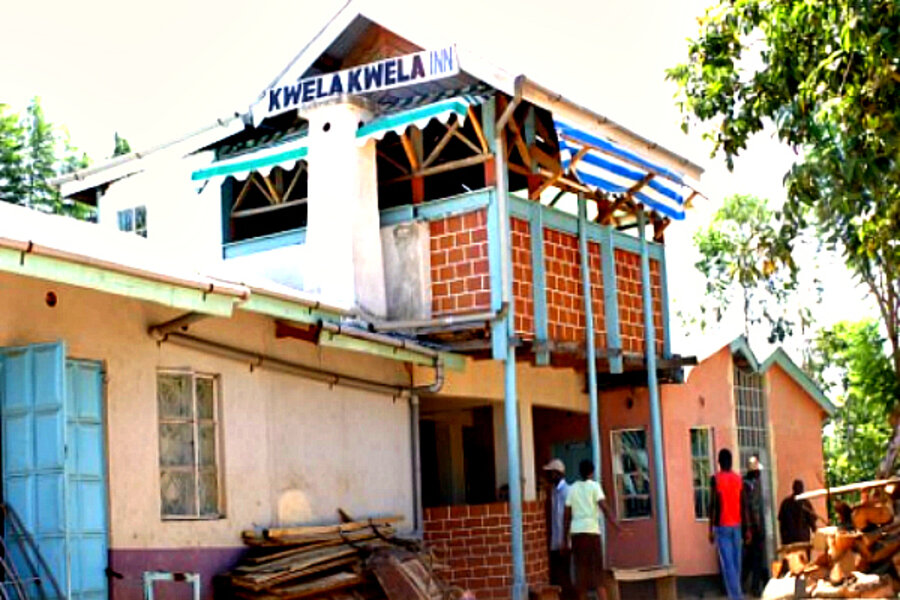Water harvesting slakes thirst at an innovative Kenyan inn
Loading...
| KAKAMEGA, Kenya
When Gaitano Likhavila was still working as an accountant at the provincial hospital in the west Kenyan town of Kakamega, he ran into a situation that got him thinking about water.
“There was a serious water shortage that made the hospital administration almost close down the hospital. At the same time, a lot of rainwater from the roofs was wasted, running down to the River Isikhu, but nobody thought of getting hold of this free water,” says Likhavila.
In 2007, he left the hospital and set up a business, now known as the KwelaKwela Inn, along the Kakamega-Kisumu highway. The venue, which occupies three-quarters of an acre, is well-known for traditional African foods, cultural performances, drinks, and lodging, and has a large garden for outdoor functions.
But as he built his business he faced one big challenge: a shortage of water. At first he paid local women to carry water on their heads from the Isikhu River, about 2 kilometers (1.2 miles) away, for cooking, drinking, washing, and other daily use.
IN PICTURES: Drought in the USA
“It was very expensive for me, because I needed a lot of water to run my business on a daily basis. Not that the water from government was not available, but it was not reliable,” he explains.
But the Isikhu River also dries up between rainy seasons when there is very little precipitation, and the situation has been getting worse each year due to changes in the weather patterns, experts say.
“Today there is no predicting [the weather],” said Moses Agumba, head of the Lake Victoria South Water Services Board, which operates in the area. Increasing deforestation and climate change have made rainfall erratic, he said.
The Lake Victoria Water Development Authority, a government department that connects homes to piped water supplies, depends on the Isikhu River to pump water into its storage facilities. When water shortages hit, rationing becomes the only way to serve the population.
Likhavila didn’t see the point in applying for a water connection for his business, as it was expensive and unreliable.
“I saw that I needed a lot of water. I thought very hard and came up with an idea of harvesting my own water,” he says.
He paid some men to dig a hole 10 feet deep and 10 feet wide. He used the soil to bake bricks for the construction of an underground tank, and bought iron bars, wire mesh, and water-proof cement.
He then got a plumber to fit a network of pipes around the edges of his sheet-iron roof, channeling rainwater runoff into the tank.
Today there is a dining area for visitors on top of the underground tank, and all that can be seen of it is a lid and an electric pump in the corner that draws up water.
Likhavila has also installed plastic water-storage tanks on his roofs. He pumps water from the underground tank up to these roof tanks to supply the guest rooms, toilets, bathrooms, kitchen, bars, and restaurant.
“I get a lot of water when it rains,” he says. “I first fill the overhead tanks, which can take several weeks to empty.”
Once all the tanks are full, an outlet directs water to the vegetable garden. He also has a car-washing bay that uses water from the tanks.
Likhavila says his system stores enough water to get him through most of the year. He only suffers from water shortages, usually lasting two to three weeks, at times when droughts are particularly severe. And his system allows him to capture more of the region’s increasingly intense rains.
The total cost of constructing the tank system was around 60,000 Kenyan shillings ($700), with the main expenses being labor and materials.
“For these past few years, I would have been spending more than 5,000 Ksh (about $60) every month paying for piped water from the government,” he says. Since 2007, he would have spent as much as $4,000 on water bills, he calculates.
Officials from the local water department found it hard to believe that such a thriving business could run without piped water. They suspected Likhavila might have been siphoning water illegally from the municipal supply.
They came to investigate and saw the water-harvesting tank system for themselves. Then they wanted to check that the water was safe for human consumption.
“They found that I treated the water with chlorine, and it tasted sweeter than the piped water. They left me alone,” says Likhavila.
He believes that water harvesting is the solution to the water shortages experienced by small-scale farmers and the rural poor during dry spells.
“Farmers should stop cursing climate change when there is a simple way of storing water,” he says. “And I would encourage them to construct underground tanks, because the water is as cold as if it had come from the fridge and it is very clean.”
If farmers installed a similar system, their livestock would not die and they would have enough water for drinking and other household uses as well as irrigation, he says.
Likhavila says other people from the area now are coming to see how he built his system, with a view to doing the same. Many are his old colleagues at the water-short hospital.
“Hospital officials have visited me to learn about this innovation, and are now planning to start constructing tanks to store water for hospitals and other institutions,” he says.
• Pius Sawa is a freelance science journalist based in Nairobi, Kenya.
This article originally appeared at Alertnet, a humanitarian news site operated by the Thomson Reuters Foundation.
• Sign up to receive a weekly selection of practical and inspiring Change Agent articles by clicking here.







